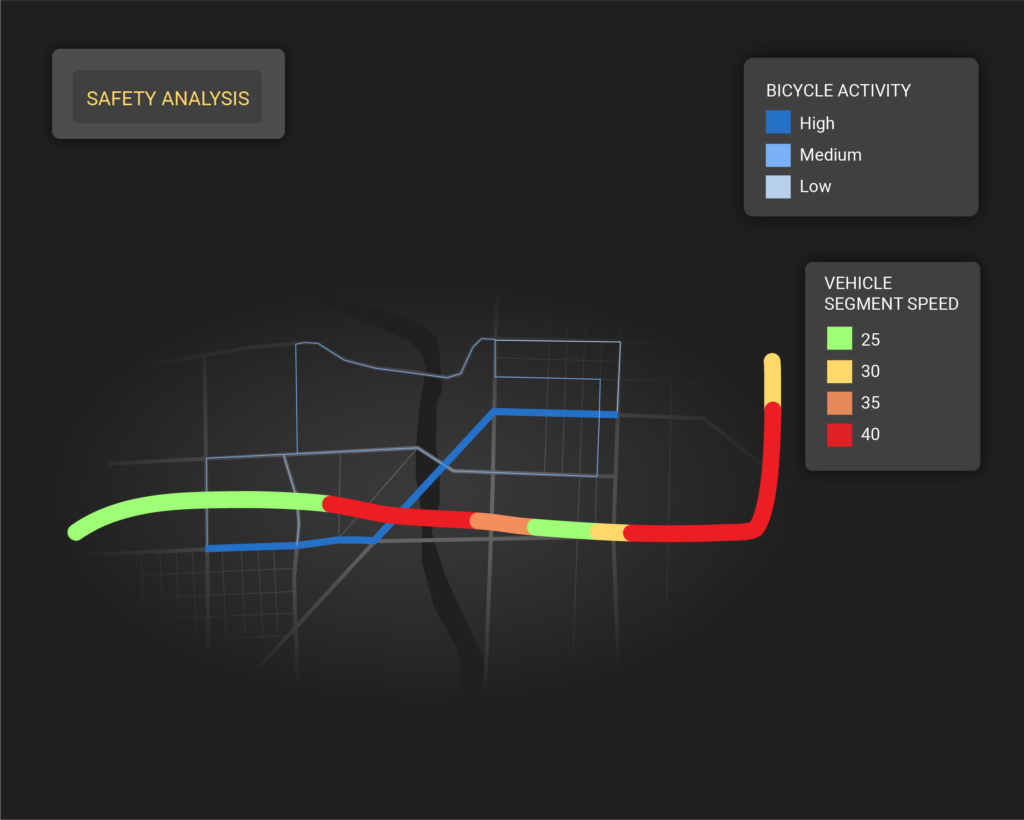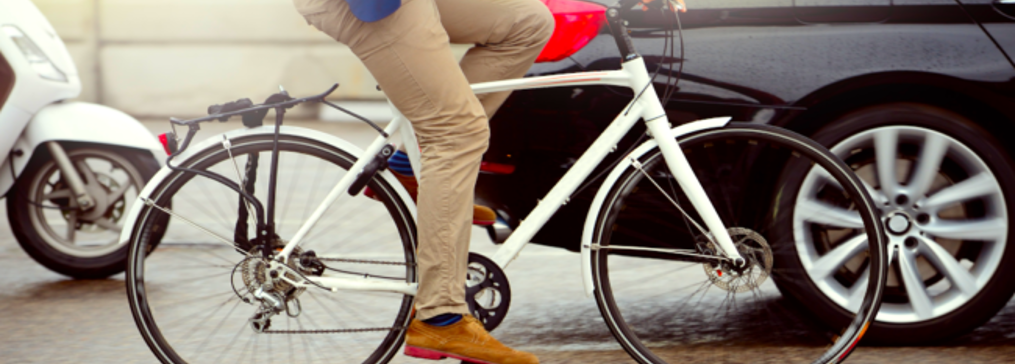
Jump Ahead

As concerns around productivity, sustainability, efficiency, and social equity have grown across the U.S., so has the importance of mobility. And though transportation infrastructure has been advanced and codified over centuries under the formal governance of federal and state-level Departments of Transportation (DOTs), Metropolitan Planning Organizations (MPOs), local municipalities, and certain commercial bodies, there is still a long way to go to ensure safe, accessible, and equitable mobility for all.
To make progress, it helps to understand the difference between mobility as a holistic term and transportation as a narrower focus. Mobility is a more comprehensive topic, and moves beyond physical transportation into the whole ecosystem. An analysis of mobility issues may show that some Americans have only limited access to transportation modes, thus limiting their mobility. Some legacy transportation modes only work independently of others and contribute to growing sustainability worries.
This article explores why local authorities and enterprise companies must pay close attention to mobility in transportation. It also suggests ways to take advantage of the tremendous wealth of data that’s now available to help with planning and growth.
We’ll focus on the following areas:
- Defining Transportation and Mobility
- Why Does Mobility Matter?
- What’s the Difference between Mobility on Demand and Mobility as a Service?
- Smart Transportation and Mobility
- The Data Behind Better Mobility
Defining Transportation and Mobility
Transportation refers to how goods and people move from point to point. It includes elements such as infrastructure, vehicles, fuel, regulation, logistics, and technology. For example, planners need to decide if roads, highways, bridges, and public transit systems have sufficient capacity or efficiency.
Mobility looks beyond the “nuts and bolts” of transportation to assess how systems offer good access and ease of movement to people and things. The distinction may seem subtle, but focusing on how much people have the ability to move helps highlight factors of accessibility and equity.
A transportation system might provide the opportunity for people and things to move from place to place in one way or another, but a person may still be immobile within this system due to factors like disability, poverty, racial profiling and discrimination, or an inability to understand the language of roadway signs or public transit instructions.
Mobility systems help make transportation more efficient, minimize congestion, reduce travel times, and ensure a good flow of people within an area. Good mobility systems also offer a variety of transportation options catering to various needs like walking, cycling or public transport, as well as shared mobility services.
What’s an Example of Good Mobility?
When a community has good mobility solutions, its people have access to various transportation services, some of which cater to the individual needs of those on low income, the elderly, or people with disabilities. When new infrastructure or policy is added to the community, efforts are made to ensure it is equitable and inclusive. This in turn means people can use the transportation network to easily access essential services like recreation, education, healthcare, and employment.
Why Does Mobility Matter?
Mobility issues affect the economy, the environment, safety, and social equity in many ways.
Productivity and the Economy
While transportation networks are built to enable to movement of people and goods, mobility focuses on the factors that impact people and things’ ability to move. Therefore, while the movement of goods via freight, aircraft, and ships is one key way transportation systems impact the economy, a focus on mobility will further highlight the human elements of a well-functioning economy.
We’ve already noted that a good mobility system ensures people can access places of employment, the healthcare that keeps them well enough to work, and education systems that can help prepare them for specialized labor and teach financial literacy. In addition, when mobility systems are efficient, commute times are reduced, delivery drivers arrive quickly, and customers have easy access to goods and services.
Studies confirm that when mobility is compromised, retail businesses suffer. For example, when vehicle and pedestrian traffic dropped during the pandemic, retail vacancies also spiked. As people regained some of their mobility and traffic began to recover, so did retail vacancy rates, though the impact of COVID still lingers in many cities.

Social Equity and Quality of Life
Mobility improves the quality of life within communities, giving access to careers, healthcare, education, and recreation. Likewise, mobility supports social inclusion, giving people convenient access to spaces of shared community, governance, care, culture, and more. Public transportation is a key part of creating convenient, accessible access to these facets of social life, yet 45% of Americans have no access to it. [1]
If people do not have equitable access to transportation modes, this inevitably leads to disparity and social injustice. [2] Planners can consider topics like “spatial mismatch,” where there’s a lack of connectivity between employment centers and communities. They may investigate countermeasures such as reverse commuting, to connect low-income city areas to a suburban job center.
Sustainability and Climate
Safe access to more modes of transportation helps reduce the environmental impact of transportation. Planners can promote sustainable options like walking or cycling and provide infrastructure to encourage electric vehicles. These solutions help reduce pollution and improve overall quality of life.
Meanwhile, extreme weather events are in the news, and mobility systems need to become far more resilient in the face of climate change. [3] For example, rising sea levels and extreme storms cause flooding and storm surges, which damage roads and bridges. Over time, this can also weaken roadway materials, leading to higher repair bills and traffic congestion.
Excessive heat could also damage rail tracks and cause cracks to appear in roads, posing safety risks for travelers and transportation workers.
As the climate crisis causes more extreme weather events like wildfires, floods, and landslides, the ability to evacuate also becomes all the more critical to saving lives. Access to safe modes of transportation and evacuation routes with enough capacity to support mass travel out of an affected area can become major factors to survival, as well as the ability to return, recover, and rebuild after disaster strikes.
Congestion and Commuting
The economic cost of congestion is significant, especially in large cities. It can lead to wasted time, energy, and fuel as commute times stretch and people take more time on the way to work. To relieve congestion, transportation agencies might add separate bus or bike lanes, or completely redesign a busy intersection to improve flow. For example, they may convert the intersection into a traffic light-controlled operation or install a roundabout.
Get your Guide to the Transportation Data Revolution
Download data guideSafety
Safety and mobility are intrinsically linked. When people do not have access to safe means of travel, their mobility is dramatically reduced. Vice versa, if someone is not mobile, they will likely lack access to resources that keep them safe.
For example, if someone who relies on public transit to get around does not have a safe pedestrian path that can take them from a bus stop to a healthcare facility, they may be forced to miss doctor’s appointments because they cannot travel without putting themself in danger. Simultaneously, this lack of access to medical care also makes them vulnerable to disease, disability, and death.
The danger people face on U.S. roads mustn’t be understated. Although there was a slight decrease in road fatalities across the US in 2022, these deaths represent a rate of 1.35 fatalities per 100 million vehicle miles traveled.4 In addition, pedestrian fatalities actually increased over this period, even as pedestrian activity plummeted.
Although vehicle safety regulations in the U.S. have improved over the years, they still leave much to be desired, and fail to take into account the safety of those outside vehicles such as cyclists, pedestrians, and road workers. Our Transportation Safety Data Handbook has more information on how transportation professionals can assess road safety and move toward safer infrastructure and operations.

What’s the Difference between Mobility on Demand and Mobility as a Service?
While infrastructure and policy are critical to mobility, recent technological developments also hope to advance urban mobility. Two key developments in this area have been the emergence of mobility-on-demand (MoD) and mobility-as-a-service (MaaS) technologies.
MoD provides on-demand access to a range of transportation systems throughout the community. These could include micro-mobility (small, low speed, electrically-powered transportation options) or ride-sharing solutions such as Lyft or Uber.
On the other hand, MaaS has a more integrated and broader focus involving a range of transportation modes. These might also include ride sharing, but extend to public transit and more, providing an end-to-end and seamless transportation experience for a range of users.
For example, apps can be used to deliver real-time information about public transportation, including train and bus schedules as well as info about ride-sharing options so people can plan their journeys.
MoD and MaaS are part of a larger ecosystem of smart transportation technologies that are advancing mobility, which we’ll explore next.
Smart Transportation and Mobility
Smart transportation solutions help to create more sustainable, efficient, and convenient mobility systems. These solutions rely on cutting-edge technology and connected infrastructure. Efficient services depend on the collection and analysis of data from various sources with the aim of optimizing systems and enhancing mobility. These data sources can include road sensors, mobile apps, GPS, traffic lights, connected vehicles, and more.
Because smart transportation systems often use data from personal devices like smartphones and connected vehicles, strong data privacy practices are key to ensuring positive impact. For example, you can learn how StreetLight anonymizes and validates traffic data here.
For example, smart transportation systems can support mobility by:
- Delivering relevant and up-to-date data to help travelers make better or more informed decisions. Travelers might reference public transit schedules and real-time vehicle positioning, traffic conditions, or parking availability. This can improve mobility by reducing travel time and congestion as well as boosting transit ridership.
- Creating more seamless integrations between different modes of transportation. For example, smart transportation systems might help travelers plan a route that allows them to bike safely to the nearest bus stop, and which stop to get off so that they can use a protected bike lane to travel the remaining distance. This seamlessness encourages people to rely less on private cars and plan point-to-point journeys through these multi-modal solutions.
- Providing transportation professionals with the data they need to adjust traffic signals and optimize daily operations based on real traffic patterns, leading to safer travel with less congestion.
- Minimizing human mistakes for safer roadways through collision avoidance systems and other in-vehicle smart tech.
The Data Behind Better Mobility
As noted in the section above, advancing mobility effectively relies on having actionable data about how people and vehicles move, whether they are walking, biking, busing or driving — or even using multiple modes in a single trip. Transportation professionals often rely on automatic traffic counters, manual counts, or surveys to collect this data, but these traditional methods each have limitations.
More and more, transportation planners and engineers are supplementing these traditional methods with online, on-demand traffic data platforms, which use big data methods to deliver more information for more roads and more modes, for any time of the day or year.
For example, in the video below, Xinbo Mi, a Senior Transportation Engineer at Evansville MPO explains how the agency uses big data analytics from StreetLight to understand real traveler patterns, such as the top routes people use to access a major regional hospital, and who is actually using existing infrastructure.
For more resources to help you leverage big data for better mobility in your region, check out Any Road Any Mode: Guide to the Transportation Data Revolution.
- NHTSA 2022 Roadway Fatalities. https://www.nhtsa.gov/press-releases/traffic-crash-death-estimates-2022
- Urban Mobility Report 2019. https://trid.trb.org/view/1647076
- Transportation Justice, Commuter Knowledge, and Equitable Access. https://penntoday.upenn.edu/news/transportation-justice-commute-knowledge-and-equitable-access
- Climate Change Impacts on Transportation. https://www.epa.gov/climateimpacts/climate-change-impacts-transportation

Expand mobility for your community with data-driven transportation planning
Download Data GuideReady to dive deeper and join the conversation?
Explore the resources listed above and don’t hesitate to reach out if you have any questions. We’re committed to fostering a collaborative community of transportation professionals dedicated to building a better future for our cities and communities.